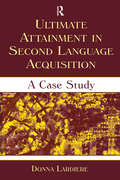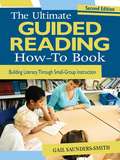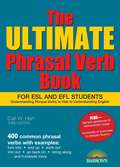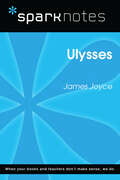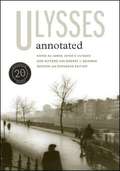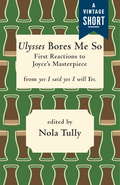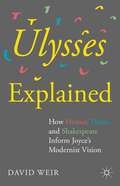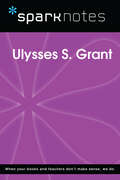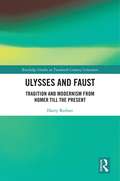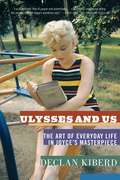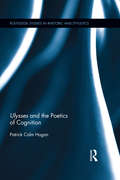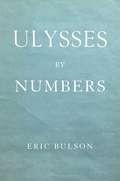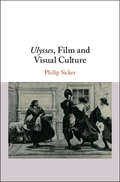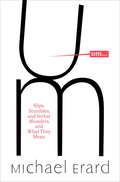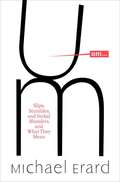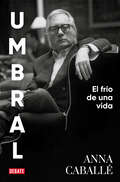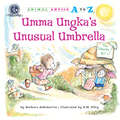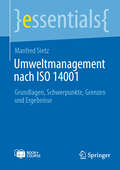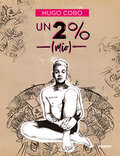- Table View
- List View
Ukrainische Literaturgeschichte
by Ulrich SchmidDer offene Überfall Russlands auf die Ukraine im Februar 2022 hat der westlichen Öffentlichkeit die Wichtigkeit der ukrainischen Kulturgeschichte bewusst gemacht. Es mangelt allerdings an grundlegenden Handbüchern. Auf Deutsch liegt keine ukrainische Literaturgeschichte vor, die einen Überblick über die wichtigsten Autorinnen und Autoren sowie die Entwicklung der literarischen Genres geben würde. Es gibt eine Reihe von Fragen, der sich eine ukrainische Literaturgeschichte stellen muss. Wann und mit welchen Texten beginnt die Geschichte der ukrainischen Literatur? In welchen Sprachen und in welchem Raum vollzieht sie sich? Welche regionalen Besonderheiten sind zu beachten? Welche institutionellen Bedingungen ermöglichen und behindern den literarischen Prozess in der Ukraine? Schließlich ist noch auf ein wichtiges Spezifikum hinzuweisen. Eine ukrainische Literaturgeschichte kann keine Darstellung eines literarischen Prozesses sein, der unabhängig von seiner eigenen Reflexion, Historisierung und Institutionalisierung abläuft. Mit anderen Worten: Die ukrainische Literaturgeschichte „entstand“ nicht einfach, sondern sie wurde über weite Strecken als gewollte kulturelle Ordnung konstruiert.
Ulrike Meinhof and the Red Army Faction
by Leith PassmoreWith a communicative approach to the phenomenon of terrorism and new archival sources, the book documents Meinhof's journalism and terrorism (1959-1976) and challenges many of the established narratives that have calcified around the story of Meinhof and the history of Germany's most infamous terrorist group.
Ultimate Attainment in Second Language Acquisition: A Case Study
by Donna LardiereThe first book-length treatment of its type, Ultimate Attainment in Second Language Acquisition is a case study with a solid theoretical grounding that examines the language of an immigrant learner of English, and thereby presents a much needed understanding of the linguistic competence of second language speakers. Based on longitudinal data collected over a period of 16 years, this clear and accessible presentation is well-grounded in linguistic theory and in second language acquisition research issues. Author Donna Lardiere presents the narrative of Patty, an adult Chinese immigrant learner of English, who achieves native-like proficiency in some areas of her English idiolect, although reaches a plateau in her language acquisition, known as the concept of fossilization. By addressing this concept, a central idea in second language acquisition research, Lardiere fills a void in existing literature. Individual chapters focus on Patty’s end state knowledge of grammatical areas of finiteness, past-tense marking, word order, wh-movement and relativization, passivization, number marking, and use of determiners. Important topics discussed throughout the book include:*learner variability in production;*case study methodology;*the roles of motivation and prior language (L1) knowledge; and*sensitivity to input in circumscribing ultimate attainment in adult second language acquisition. Ultimate Attainment in Second Language Acquisition is intended for anyone whose research is in the areas of second language acquisition, language acquisition, theoretical, applied, or developmental linguistics. It is also appropriate for graduate level students of TESOL and teachers who work with more advanced learners of foreign languages.
Ultimate Guided Reading How-To Book: Building Literacy Through Small-Group Instruction
by Gail Saunders-SmithGeared towards primary school teachers to understand the foundation for literacy development
Ultimate Phrasal Verb Book, 3rd edition: For Esl And Efl Students
by Carl W. HartUpdated to reflect questions found on the most recent ESL tests, this book presents 400 common phrasal verbs as they are used in everyday English. Phrasal verbs are verbs combined with prepositions or adverbs. Familiarity with phrasal verbs and understanding their use as nouns (breakup, showoff, etc.) or adjectives (spaced-out, broken-down, stressed-out, and many others) is essential to ESL students. Updated information includes: the most commonly used phrasal verbs; activities and examples that reflect our current technology and the world around us; an expanded introduction for the teacher with a thorough breakdown and explanation of phrasal verbs; and, a discussion of separable and inseparable phrasal verbs in Unit I, and more. This book’s hundreds of examples in context and hundreds of exercises will be extremely useful to ESL students who are preparing for TOEFL or who simply wish to improve their English.
Ulysses (SparkNotes Literature Guide Series)
by SparkNotesUlysses (SparkNotes Literature Guide) by James Joyce Making the reading experience fun! Created by Harvard students for students everywhere, SparkNotes is a new breed of study guide: smarter, better, faster. Geared to what today's students need to know, SparkNotes provides: *Chapter-by-chapter analysis *Explanations of key themes, motifs, and symbols *A review quiz and essay topicsLively and accessible, these guides are perfect for late-night studying and writing papers
Ulysses Annotated: Notes for James Joyce's Ulysses (Revised and Expanded Edition)
by Robert J. Seidman Don GiffordPresents annotations to Joyce's classic that can inform any reading of "Ulysses". This volume includes annotations that gloss place names, define slang terms, give capsule histories of institutions and political and cultural movements and figures, supply bits of local and Irish legend and lore, and explain religious nomenclature and practices.
Ulysses Bores Me So
by Nola TullyThe publication of James Joyce's Ulysses was met with both hyperbolic praise and scorn: was Joyce's evocation of a day in the life of Leopold Bloom's Dublin a work of genius? Or was it drivel? Was it "an entirely new thing" (W. B. Yeats), or "a turgid welter of pornography" (Edith Wharton)? A "work of high genius" (Edmund Wilson) or something rather slighter: "Never did I read such tosh," Virginia Woolf wrote. In "Ulysses Bores Me So," a selection from the Bloomsday compendium yes I said yes I will Yes., the evidence is laid bare: the first reviews, letters, and reactions to the book that would change the course of literary history.
Ulysses Explained: How Homer, Dante, and Shakespeare Inform Joyce’s Modernist Vision
by David WeirIn 1929, T. S. Eliot claimed that "Dante and Shakespeare divide the modern world between them; there is no third. " Ulysses Explained argues that James Joyce may now be numbered along with Dante and Shakespeare among the giants of Western literature whose stature and status as an artist of the modern world has been confirmed by tradition. But there is another who walks beside them, closer to Dante and Joyce, certainly, though he occasionally brushes up against Shakespeare as well: the ancient poet Homer. These three figures command attention in any reading of James Joyce's Ulysses: Homer because he provides the narrative, Shakespeare because he supplies the plot, and Dante because he inspires the structure. This book shows how Joyce adapts classical, medieval, and renaissance traditions in Ulysses to advance his own modernist agenda of fragmented narrative, experimental structure, and psychosexual complexity.
Ulysses S. Grant (SparkNotes Biography Guide)
by SparkNotesUlysses S. Grant (SparkNotes Biography Guide) Making the reading experience fun! SparkNotes Biography Guides examine the lives of historical luminaries, from Alexander the Great to Virginia Woolf. Each biography guide includes:An examination of the historical context in which the person lived A summary of the person&’s life and achievements A glossary of important terms, people, and events An in-depth look at the key epochs in the person&’s career Study questions and essay topics A review test Suggestions for further reading Whether you&’re a student of history or just a student cramming for a history exam, SparkNotes Biography guides are a reliable, thorough, and readable resource.
Ulysses and Faust: Tradition and Modernism from Homer till the Present (Routledge Studies in Twentieth-Century Literature)
by Harry RednerUlysses and Faust: Tradition and Modernism from Homer till the Present examines the most important authors of Western literature: Homer, Virgil, Dante, Shakespeare, Cervantes, Marlowe, Goethe, Joyce, Eliot, Mann, Bulgakov and Pasternak, who based their works on one or other of the two key myths of the West, Ulysses and Faust. This volume provides a synoptic view of Western literature, as a foundation text for literary studies at all levels and as a way of encouraging people to once more engage with the major authors of our literary heritage. Ulysses and Faust considers the artistic revolution known as Modernism at the start of the twentieth century and the subsequent events in Europe, such as the World Wars and the totalitarian regimes, which led to a major break in Western civilization reflected in its literature. Consequently, these detailed critical studies illuminate their authors’ Weltanschauung, their view of life as it was lived in their time.
Ulysses and Us: The Art of Everyday Life in Joyce's Masterpiece
by Declan KiberdJames Joyce's famous 1922 novel Ulysses has been "wrenched out of the hands of the common reader" by esotericizing specialists, complains Kiberd (Anglo-Irish literature, U. College Dublin, Ireland), which is unfortunate because for all of its complexities the "underlying intention [of Joyce] was that anyone reading Ulysses could be an expert, at least in the sense that anyone present at a sporting event feels entitled to have a valid opinion on what transpires." He takes the reader through the episodes of Ulysses, focusing on themes of mundane pleasures, such as waking, walking, and drinking, in order to foster appreciation of Joyce's masterwork and better understanding of Joyce's work as a celebration of the richness of Irish daily life and popular culture. Annotation c2010 Book News, Inc., Portland, OR (booknews.com)
Ulysses and the Poetics of Cognition: Ulysses And The Poetics Of Cognition (Routledge Studies in Rhetoric and Stylistics)
by Patrick Colm HoganGiven Ulysses’ perhaps unparalleled attention to the operations of the human mind, it is unsurprising that critics have explored the work’s psychology. Nonetheless, there has been very little research that draws on recent cognitive science to examine thought and emotion in this novel. Hogan sets out to expand our understanding of Ulysses, as well as our theoretical comprehension of narrative—and even our views of human cognition. He revises the main narratological accounts of the novel, clarifying the complex nature of narration and style. He extends his cognitive study to encompass the anti-colonial and gender concerns that are so obviously important to Joyce’s work. Finally, through a combination of broad overviews and detailed textual analyses, Hogan seeks to make this notoriously difficult book more accessible to non-specialists.
Ulysses by Numbers
by Eric Jon BulsonUlysses has been read obsessively for a century. What if instead of focusing on the words to understand the structure, design, and history of Joyce’s masterpiece, we pay attention to the numbers?Taking a computational approach, Ulysses by Numbers lets us see the novel’s basic building blocks in a significantly new light—words, paragraphs, pages, and characters, as well as the original print run and the dates marking the beginning and end of its composition. Numbers provide access into Joyce’s creative process, enhanced by graphs, diagrams, timelines, and maps, and they also give us a startling new perspective on the proportions that continue to structure, organize, and pace the reading experience. Numbers are there to help us navigate the history of Ulysses from its earliest material beginnings, and they offer a concrete basis upon which we can explore the big questions about its length, style, origins, readership, and design.An innovative computational reading on both a micro and macro level, Ulysses by Numbers is a timely intervention into debates about the use and abuse of quantitative methods in literary analysis. Eric Bulson demonstrates how reading by numbers can bring us closer to the words of Ulysses, helping us rediscover a novel we thought we already knew.
Ulysses on the Liffey
by Richard EllmannThe author of modern biographies lucidly disentwines the narrative, ethical, aesthetic, and ultimate levels of James Joyce's masterpiece Ulysses. Much of the evidence is internal, but he also makes the first use of some important indications by Joyce himself.
Ulysses, Film and Visual Culture
by Philip SickerAlthough Joyce was losing his sight when he wrote Ulysses, Stephen's and Bloom's visual experiences are extraordinarily rich and complex. Absorbing the influences of popular visual attractions such as dioramas, stereoscopes and mutoscopes, their perceptions of Dublin are shaped by what Walter Benjamin calls 'unconscious optics'. Analyzing closely the texture of their impressions and of Joyce's prismatic narrative styles, Philip Sicker explores the phenomenon of sight from a wide-ranging set of perspectives: eighteenth-century epistemology (Locke and Berkeley), theories of the flaneur (Baudelaire and Benjamin), Italian Futurist art (Marinetti and Boccioni), photography (Barthes and Sontag), and the silent films Joyce watched in Dublin and Trieste. The concept of 'spectacle' as a mechanically-constructed visual experience informs Sicker's examination of mediated perception and emerges as a hallmark of modernist culture itself. This study is an important contribution to the growing interest in how deeply the philosophy and science of visual perception influenced modernism.
Um . . .: Slips, Stumbles, and Verbal Blunders, and What They Mean
by Michael ErardIn this account of language in the wild, linguist and writer Michael Erard explains why our attention to some verbal blunders rises and falls. Why was the spoonerism named after Reverend Spooner and not some other absentminded person? Where did the Freudian slip come from? Why do we prize "umlessness" in speaking? And how do we explain the American presidents who are famous for their verbal blundering? You'll have new ways to listen to yourself and others once you've met the people who work with verbal blunders every day - journalists, transcribers, interpreters, police officers, linguists, and psychologists, among others - and once you've learned what verbal blunders tell us about who we are and what we want
Um Quarto Só Seu
by Virginia WoolfCONSIDERADO UM DOS TEXTOS MAIS IMPORTANTES DO SÉCULO XX, UM QUARTO SÓ SEU MARCA UM MOMENTO FUNDADOR DO FEMINISMO MODERNO. UM ENSAIO MARCANTE DE UMA AUTORA INCONTORNÁVEL DO PENSAMENTO MODERNO, VIRGINIA WOOLF, AGORA NOS PENGUIN CLÁSSICOS. COM PREFÁCIO DE ANA LUÍSA AMARAL. «Tranquem as vossas bibliotecas se quiserem; mas não há portão, não há cadeado, não há ferrolho com que possam prender a liberdade do meu espírito.» Em 1928, Virginia Woolf foi convidada pela Universidade de Cambridge a dar, nos colégios femininos da instituição, uma palestra sobre mulheres e ficção. Com a frontalidade que o tema exige, Woolf resolve, sem subterfúgios, a equação: para escrever ficção, «uma mulher tem de ter dinheiro e um quarto só seu». Dito de outro modo, tem de ser livre. Versando sobre as condições materiais e sociais necessárias para que uma mulher possa, se assim o desejar, escrever e criar, e explorando os efeitos da pobreza e do constrangimento sexual na criatividade feminina, Virginia Woolf ofereceu ao seu auditório e a todas as gerações que se seguiram uma reflexão provocadora e estimulante sobre a condição da mulher e a alienação social a que foi, desde a Antiguidade, sujeita num mundo dominado por homens. Considerado um dos textos mais importantes do século XX, Um Quarto Só Seu marca um momento fundador do feminismo moderno, que devolve à esfera política uma luta antiga e justa: a da igualdade.
Um...Slips, Stumbles, and Verbal Blunders, and What They Mean
by Michael ErardJournalist and language expert Erard argues that the secrets of human speech are present in our verbal blunders as he studies and interprets speech errors--hilarious bloopers, Spoonerisms, and malapropisms.
Umbral: El frío de una vida
by Anna CaballéCrónica de un dandy español en el 15 aniversario de su muerte. La publicación de El frío de una vida, en 2004, marcó un antes y un después en el dominio del género de la biografía española. La brillante y rigurosa interpretación que se hacía de la escritura umbraliana a partir de los obstáculos y dificultades reales que no dejaron de asediar al escritor a lo largo de su vida (1932-2007) -y que hasta entonces habían permanecido ocultos- supuso una novedad y también un desafío. Anna Caballé fijó las circunstancias en las que transcurrieron la infancia y adolescencia de Francisco Umbral y su llegada a Madrid. También analizó y contextualizó en profundidad su incansable labor como articulista y escritor y su relación con las mujeres y el poder, todo ello construido en el libro con una pasión contenida que, sin embargo, es siempre muy perceptible en el estilo de la autora. El resultado fue un libro iluminador, valiente y arriesgado que huía de los cumplidos para exponer los hechos más relevantes de la vida de Umbral, sin obviar tampoco una posible interpretación de los mismos. La biografía de un escritor vivo como no se había escrito hasta entonces en España. Casi veinte años después de aquella edición, se reedita revisada y con los imprescindibles ajustes que incluyen el cierre de los interrogantes que en la primera edición quedaron sin resolver.
Umm Kulthum: Artistic Agency and the Shaping of an Arab Legend, 1967–2007 (Music Culture)
by Laura LohmanHow an extraordinary woman shaped her career and legacy through war In 1967 Egypt and the Arab world suffered a devastating defeat by Israel in the Six-Day War. Though long past the age at which most singers would have retired, the sexagenarian Egyptian singer Umm Kulthum launched a multifaceted response to the defeat that not only sustained her career, but also expanded her international fame and shaped her legacy. By examining biographies, dramas, monuments, radio programming practices, and recent recordings, Laura Lohman delves into Umm Kulth m's role in fashioning her image and the conflicting ways that her image and music have been interpreted since her death in 1975.
Umma Ungka's Unusual Umbrella (Animal Antics A to Z)
by Barbara deRubertisUmma Ungka stumbles and bumbles. She trips and tumbles! The summer sun is making her feel dizzy and muddled! But Uncle Ungka might have just the solution to keep Umma cool as a cucumber all summer long.
Umrisse einer Dritten Kultur im interdisziplinären Zusammenspiel zwischen Literatur und Naturwissenschaft: Jahrbuch des Instituts für moderne Fremdsprachen an der Naturwissenschaftlich-Technischen Universität Norwegens (NTNU) in Trondheim (ELECTRISCHER PROMETHEUS. Umrisse einer Dritten Kultur im interdisziplinären Zusammenspiel zwischen Literatur und Naturwissenschaft)
by Bernd NeumannIn diesem Open-Access-band geht es um die Thematisierung des Verhältnisses zwischen den gegenwärtig getrennten „Zwei Kulturen“ und Umrisse ihrer neuen Synthese in Richtung auf eine zeitgenössische, auf Interdisziplinarität gegründeten „Dritten Kultur“ als Zusammenschau von Literaturwissenschaft, Philosophie und Naturwissenschaft. Dabei wird Kafka als ein Autor ernst genommen, dessen Nähe zu Autoren der Romantik (Kleist etwa als einer seiner „Blutsbrüder“) ihn dazu bestimmte, deren zentrales Interesse an der Elektrizität (in Form des Mesmerismus beispielsweise) zu teilen. Als eine Weiterführung hinein in die neueste Moderne gelangt Kafkas besondere Begegnung mit Einstein und dessen Relativitätstheorie zur Darstellung, deren Einwirkung insbesondere auf Kafkas Spätwerk dargelegt wird. Als moderne Spielform solch „electrisch“- transdisziplinär orientierten literarischen Schreibens wird diesen Ausführungen Botho Strauß` gegenwärtiges Novellenwerk zur Seite gestellt.
Umweltmanagement nach ISO 14001: Grundlagen, Schwerpunkte, Grenzen und Ergebnisse (essentials)
by Manfred SietzUmweltmanagement eines Unternehmens bedeutet, die Umweltauswirkungen minimierend zu managen, um die Qualität unserer Umwelt zu erhalten oder zu verbessern. Managen bedeutet in der Originalübersetzung etwas zu verwalten. Also eine Aufgabe mit Verantwortung, Zielen und Aktivitäten. Alle diese Managementtools werden zuzusammengefasst in der weltweit gültigen und zertifizierbaren Norm ISO 14001.
Un 2% (mío)
by Hugo CoboHugo Cobo, exconcursante de Operación Triunfo, nos trae su proyecto más personal. Las personas somos como los icebergs: dejamos ver una pequeña parte de nosotros, pero ocultamos otra mucho mayor bajo el agua . Es allí donde se encuentran nuestros sueños, nuestros miedos, los mejores momentos de nuestras vidas, las partes más difíciles... y lo que queda en la superficie es solo un 2% de todo eso. Hay que ser valiente para atreverse a bucear y descubrir qué se esconde más allá de lo que está a simple vista. Tienes entre tus manos esa parte oculta de mí, ese "yo" desconocido, todo lo que viene después del 2% que ves.


